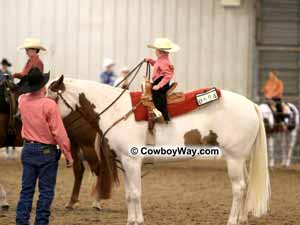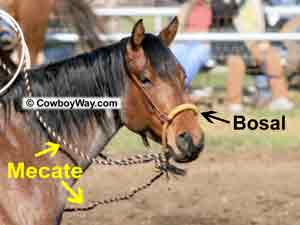Cowboy Dictionary - Letter K-M
Kid Broke Horse - A horse that has been trained to be ridden and is considered to be gentle and safe for inexperienced riders of any age.
Below: A kid broke horse.

Lariat - A rope used by cowboys and cowgirls for roping cattle. Most cowboys and cowgirls simply refer to a lariat as a "rope." A lariat is also called a lasso.
Lasso - The word "lasso" can be both a noun and a verb.
As a noun, it can refer to the rope used by cowboys and cowgirls to rope cattle ("Don't forget to take your lasso").
As a verb, it can refer to the act of roping itself ("She sure lassoed that steer quick.").
Most cowboys and cowgirls simply refer to a lasso as a "rope," both as a noun and a verb ("Don't forget to take you rope" or "She sure roped that steer quick.")
When used as a noun, a lasso is also called a lariat.
Latigo (Definition 1 of 2) - A strap, usually made of leather or nylon, used for securing a saddle onto a horse.
A latigo is found on the left side of the saddle. It is attached to a "D" ring on the saddle, then is laced through the front cinch to secure the saddle to the horse.
Latigos have been traditionally made of leather. Today, however, nylon latigos are also common.
(By the way, the strap on the right side of the saddle that attaches to the "D" ring on the saddle, then is attached to the cinch, is called an "off billet," not a latigo.)
Below: The blue arrow is pointing to a latigo.

Latigo (Definition 2 of 2) - A type of leather.
You might like these items. Or, Article continues below.
Mare - A mature female horse.
Mark Out Rule - A rule used in the rodeo events of saddle bronc riding and bareback bronc riding that requires bronc riders to have the rowels of both spurs in front of, and touching, the break of the bronc's shoulders on its first move out of the chute.
The rider's feet must still be in this position when the bronc's front feet hit the ground for the first time. This is called "marking a horse out."
For more information about the mark out rule, please see our article The Mark Out Rule.
Below: This saddle bronc rider's left foot is in the required position to mark the bronc out. His right foot cannot be seen in the photo, but needs to be in the same position on the right side. His feet must remain in this position until the bronc's front feet hit the ground for the first time.

Mecate - A type of rein, which is a piece of equipment used for communicating with a horse while it is being ridden.
Although mecates are sometimes used with other types of equipment, such as a bit, their traditional use is with a bosal.
Mecates are made in one long piece, which, when they're not tied to a bosal, makes them resemble a rope. When properly tied to a bosal a mecate will have two main parts: 1) a loop that goes over the horse's head to make a rein on each side of the neck and 2) a lead that is used to lead the horse with from the ground.
Although mecates have traditionally been made of horsehair they are also made from nylon or other synthetic materials. The nicer horsehair mecates are made from mane hair, but some are made from tail hair, which is coarser.
Below: A mecate.

Medicine Bags - A type of saddle bag designed to hold medicine and supplies for doctoring cattle in the pasture.
Medicine bags come in a variety of styles and designs. They are typically designed to hold such items as a syringe, bolus gun, and medicines for treating sick cattle after the cowboy has roped them in the pasture.
Below: Medicine bags.

Mohair - Mohair is a fiber made from the wool of an Angora goat. Many cowboys and cowgirls are fond of cinches and breast collars made from mohair because it is durable, washable, wicks moisture away from the skin, and is naturally antibacterial: Since mohair fibers are long and smooth (unlike sheep's wool which is crimped and scaly) they naturally resist bacteria.
Below: An Angora goat, the source for the natural fiber mohair.

Mule - A mule is a cross between a male donkey (called a jack) and a female horse (called a mare). Male mules are called johns and females are called mollies. Mules are characterized by their long ears and come in a wide variety of sizes, from small pony mules to large draft mules.
Both male and female mules are almost always sterile. Even so, male mules are routinely castrated (gelded) in order to prevent the behavioral problems inherent in many studs.
Below: A mule and its rider compete in an obstacle course trail ride.

You can shop for mule headstalls here, and mule saddles here.
Muley (Or Mulee) - A casual or slang term for "polled," which means an animal that is naturally, or genetically, without horns.
An animal that was born with horns but had them removed at some point would be described as "dehorned," not polled (or not a muley).
For more information about horns, please see our article Cow Horns.
Below: A polled, or muley (or mulee), cow.

Mutton Bustin' - An event in which children ride sheep. Mutton bustin' is an event usually reserved for children too young to compete in other events commonly associated with the sport of rodeo.
In mutton bustin' the sheep are released from bucking chutes similar to the way a bronc or bull is released from a bucking chute. However, the sheep do not buck, but instead walk, trot, or run down the arena. One or more adults are in the bucking chute with the child to hold onto them until the gate opens.
In the case of a very young or timid child, an adult helper hangs onto the child during the ride and lifts them off before they have a chance to fall off. Older or less timid children attempt to ride on their own.
Mutton bustin' is also sometimes called "wool riding."
Below: A young mutton buster rides a sheep.

Definitions
… Letter C
… Letter S
… Letter T
You Might Also Like
